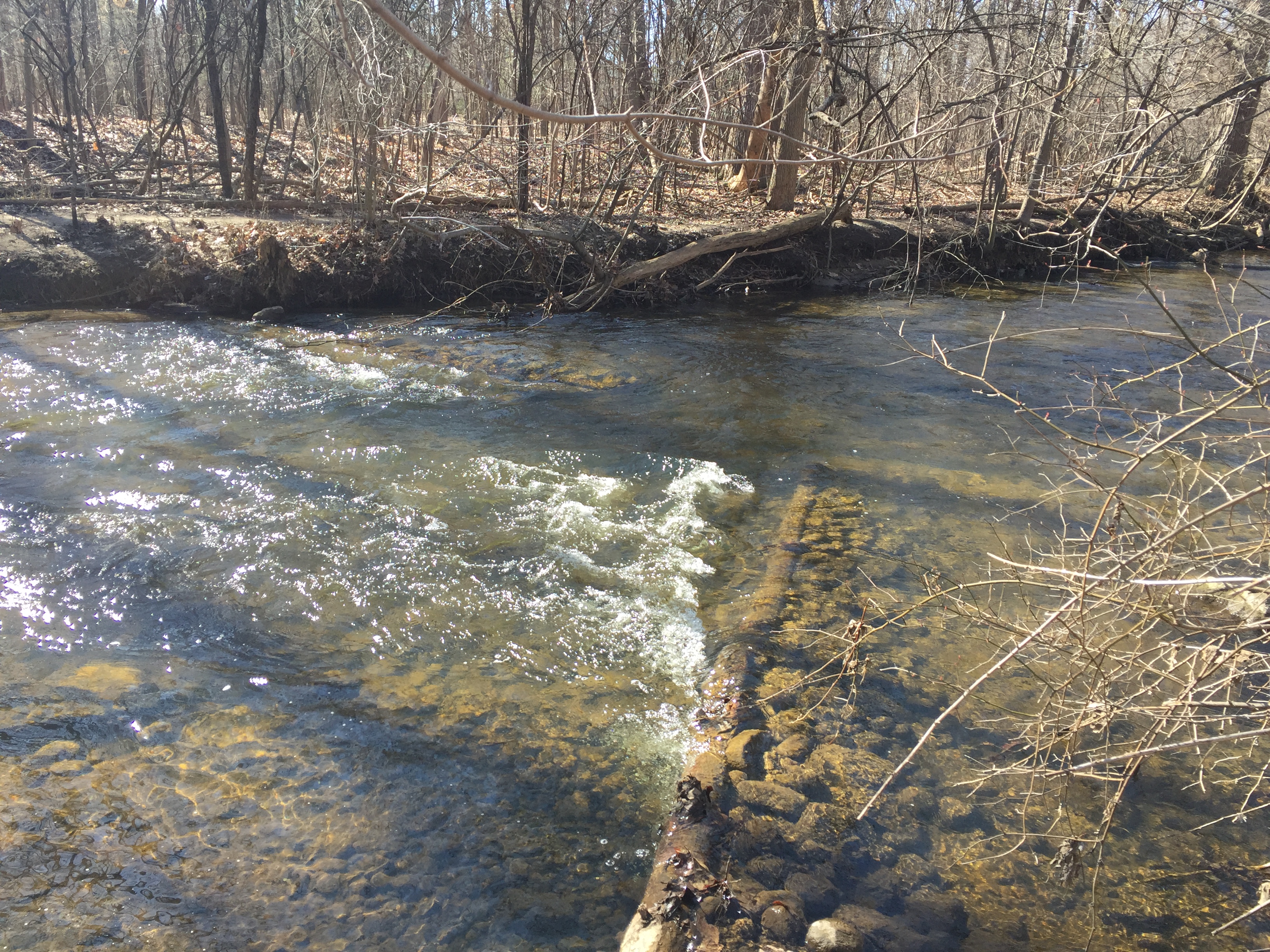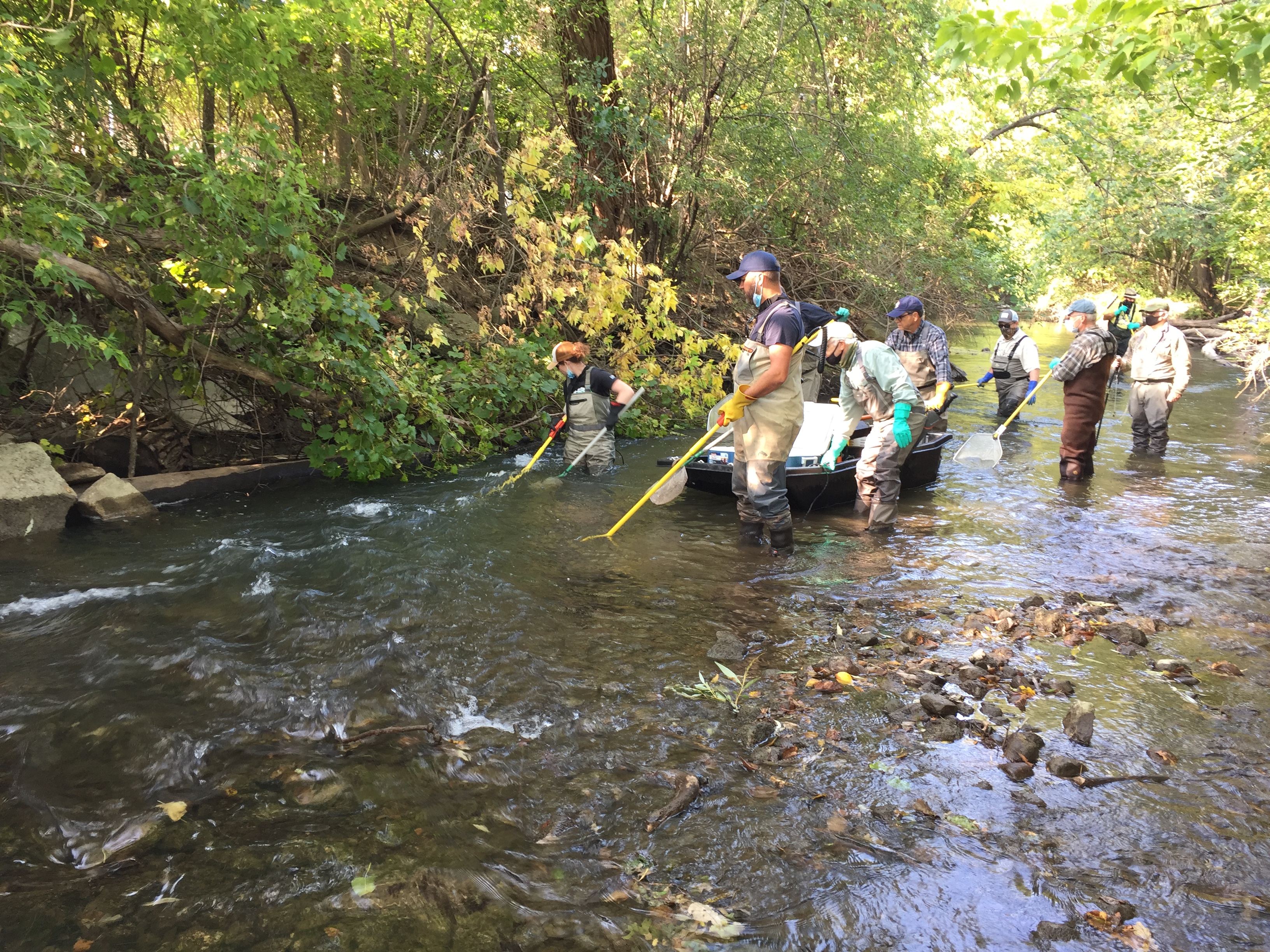Paint Creek Project Origin
by Joe Bruce, Vanguard Chapter
 How many times have you waded a stream and quickly passed thru a wide, shallow run? Slow-moving water, no instream woody debris, and no pocket water behind larger rocks indicate no need to waste time in this spot because there is no structure that could hold trout. As you pass by, have you ever considered what could be done to improve these conditions?
How many times have you waded a stream and quickly passed thru a wide, shallow run? Slow-moving water, no instream woody debris, and no pocket water behind larger rocks indicate no need to waste time in this spot because there is no structure that could hold trout. As you pass by, have you ever considered what could be done to improve these conditions?
Paint Creek, the Vanguard Chapter’s home water, is a high-quality, cold-transitional stream in Southeast Michigan. It is unique because the headwaters of the creek have a bottom draw dam at Lake Orion. During the summer, cooler water from the bottom of the dam is released into Paint Creek. As a result, the creek conditions are of such good quality that the Michigan Department of Natural Resources annually stocks a total of 7,000 brown trout in five locations.
In 2016, Kristin Thomas, aquatic ecologist, and Dr. Bryan Burroughs, executive director, both of Michigan TU, authored a report that assessed the instream fish habitat of Paint Creek. Their research began in 2015. Using a grant from the DTE Energy Foundation, Kristin hired and trained several interns in habitat mapping. Over the summer, they assessed the creek’s seventeen miles of habitat to prioritize restoration and protection initiatives. The 2016 final report documented, in detail, which sections of the stream had high-quality, instream conditions to sustain brown trout and which sections (long shallow runs or no instream habitat) did not.
In early 2017, Vanguard’s Conservation Committee Chairman Eli Stanesa analyzed the report and determined that this detailed science-based analysis should be the Chapter’s roadmap for future conservation work. With Chapter board approval, a multi-year action plan was developed. The conservation committee first reached out to Kristin to learn more about the report’s conclusions and work with her to identify the creek sections where the Chapter could do work that would have the most significant impact. She suggested they go to one of the broad, shallow, slow-moving sections where they could build some instream structures that could dramatically improve the creek’s trout habitat.
Kristin and the committee next reached out to Aaron Snell of Streamside Ecological Services (SES). Several years earlier, SES had done significant instream habitat improvement work on Paint Creek in Rochester City Park. This team of three met at a slow-moving section of the creek where the Chapter proposed to do the work and determined the installation of “vane” and log habitat structures would be an appropriate solution.
Vane structures are constructed from rocks or logs. They are built out from the stream bank at approximately a 30-degree angle pointing upstream. The engineering science behind the structures is that their positioning redirects much of the streamflow to the creek center, creating a faster, deeper, more concentrated flow. As time goes on, this faster flow digs a deeper creek bed. Vanes also encourage silt buildup near their inner angle along the bank edge, reducing stream bank erosion and narrowing the stream. Most importantly, for fish and anglers, the water flowing over the structures is agitated to reduce overhead predation and creates deeper pockets where trout can safely hide.
With a professional science-based solution in-hand, the project team needed to obtain state, city, and private landowners’ approval, as well as raise funds to do the work. Because SES was familiar with the process, they wrote and submitted an environmental permit application to the Michigan Department of Environment, Great Lakes, and Energy (EGLE) requesting authorization to install up to sixteen vane and in-stream habitat structures in a 1,500-foot length of Paint Creek over two years. SES also explained the project plan to Rochester city officials and received their approval for the work.
While SES was working on the environmental permits for Phase 1, the Chapter initiated a two-year funding plan. Approximately $9,550 was needed for the Phase 1 work. The Michigan Fly Fishing Club donated $4,695, and the Clinton Valley TU Chapter donated $500. The Vanguard Chapter funded the balance. In addition to money, the Vanguard Chapter members also provided approximately 250-man hours of volunteer labor over the two years.
During the late summers of 2018 and 2019, sixteen vanes and instream structures were installed. Their placement was selected by the SES team to optimize their effectiveness. To help scientifically assess the work’s effectiveness, Kristin returned to the creek’s improvement site and conducted electroshocking surveys in 2019 and 2020. Chapter members have assisted Kristin each year with the all-day shocking surveys. Each survey requires two passes to estimate the trout population in the project reach. Volunteers are needed to help carry the generator boat to and from the creek, push and pull the boat up the creek for two shocking runs, net the fish, mark the tail of the captured fish, and record all the data.
 In addition to electroshocking surveys, the Chapter also conducted annual “pebble count” surveys at various locations along Paint Creek. These surveys help the team track any changes in the make-up of the streambed over the years. Kristin analyzes the pebble data annually and reports the results to the Chapter. One of the pebble count survey points is within the Phase 1 stream habitat improvement zone.
In addition to electroshocking surveys, the Chapter also conducted annual “pebble count” surveys at various locations along Paint Creek. These surveys help the team track any changes in the make-up of the streambed over the years. Kristin analyzes the pebble data annually and reports the results to the Chapter. One of the pebble count survey points is within the Phase 1 stream habitat improvement zone.
After having the instream structures in place for over two years, there is no question that stream flows have improved, bank erosion has been reduced, and the channel is getting narrower and deeper. Year over year shocking results are currently being analyzed. Unfortunately, the 2020 data may be influenced when comparing it to the previous year because MDNR did no stocking in 2020 due to COVID-19 concerns. However, it appears based on the number of three-inch, or smaller, brown and rainbow trout that natural reproduction is occurring in or near the habitat improvement area.
Given the positive results seen to date, the Chapter has initiated the permitting process and fundraising to do similar work in the 1,500 linear feet immediately upstream with a shallow water structure. An Embrace-A-Stream Grant for this Phase 2 work has been received to cover the cost. The Chapter anticipates Michigan EGLE permit approval this winter and have already received landowner approval. Vane and instream woody habitat installation work should begin in the spring/summer of 2021.
The Vanguard Chapter has had outstanding participation from its members who have spent many working hours helping SES install the instream structures. About thirty, fifteen-to-thirty foot logs had to be floated into place so that four-foot-long metal spikes can be driven through the logs and into the stream bed to hold them in place during high water. Each vane installation also requires that rocks be placed on the log structures’ front side to stabilize them further and improve their effectiveness.
There is still much work to be done and data to be analyzed to validate this project’s success scientifically. But the Chapter believes that in a few years, this section of Paint Creek will improve to the point where members can conduct fish surveys using Copper Johns and Adams flies around the woody debris habitats they have installed rather than quickly passing through this formerly unproductive stretch of water. Tight Lines!
